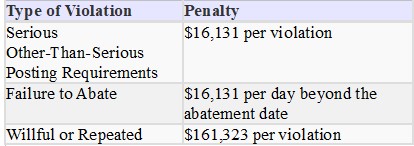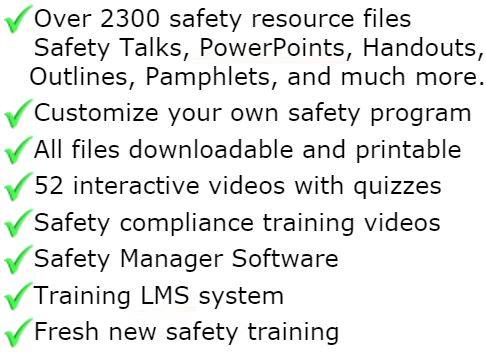
CONSTRUCTION CRANE RIGGING BASICS
This is a sample or partial document
Download the full customizable and printable version
One of the most important aspects of crane operations and lifting loads is the rigging. No matter how safe the crane and all the equipment associated with lifting, rigging continues to be a major part of crane operations and safety. Each of you who perform rigging duties are professional, experienced and fully understand the aspects of rigging safety, but this program is designed to review the basics, to make you more aware of the many safety aspects of rigging. After all, the objective is to reduce and eliminate accidents and injuries which are always tragic and costly.
One of the most important, yet basic elements of rigging safety is the hoisting triangle. The hoisting triangle consists of the crane, the operation of the crane and the rigging of the load to the crane.
First, the crane must be in good condition, properly inspected as required and generally in good, serviceable condition. Professional crane operators are extremely aware of this requirement. The second element is the knowledge and operation of the crane. The operator must fully understand the load charts, make sure the crane is set up properly, use of outriggers as necessary and must consider the radius, quadrants and operate the equipment to eliminate shock and dynamic loading. The operator must take into account any potential hazards, such as overhead obstructions and electrical lines, weather conditions and other hazards that may impact upon the safe operation of the crane. The crane operator must also insist upon good signaling and communications.
Finally, the individual attaching the load must know the weight of the load and its center of gravity, allow for appropriate sling angles, and of course make sure all the rigging hardware is in good, serviceable and safe condition. When all three elements are functioning properly, you'll have a safe lift.
Since we're assuming the crane is in good, serviceable condition and the crane operator is operating the crane in a safe manner, let's take a look at some rigging responsibilities. Knowledge of rigging is extremely critical because if you don't understand sling angles, centers of gravity and other required information, it's difficult to rig the load properly.
First, let's review the simple law of gravity. A stable load is one in which the center of gravity of the load is directly below the main hook and below the lowest point of attachment of the slings. The center of gravity of an object is that point at which the object will balance. The entire weight may be considered as concentrated at this point. Let's take a look at the center of gravity on some loads. You can see where the center of gravity is on each different load. This tells you that odd sized loads all have varying centers of gravity and it also varies with the types of slings used. As an example, we have an odd sized load and we can guess where the center of gravity is located, but until the load is lifted, you may not know exactly where that center of gravity is located. You would try to lift this load with the hook over that point and then correct it by trial and error until such time you found out the true center of gravity of this particular load.
Sling angles are critical in rigging safety, so let's quickly review some basic sling angles and why they are so important.
The rated capacities as given in the various sling catalogs and tables are based on newly manufactured slings. As the sling is used, factors such as nicking, distortion, abrasion, corrosion and other factors of use will affect the load rating and must be given consideration when lifts are planned. Because slings can be used at various angles and since rope stress increases rapidly with the angle of lift, therefore it is essential that this be considered when ordering slings. The rated load capacity of the sling decreases sharply as the angle formed by the sling leg and the horizontal becomes smaller. Let's see how this works.
First, there's a two leg sling at a 90 degree angle, lifting a one thousand pound load. Each leg of the sling has 500 pounds of stress or tension, thus the 1,000 pound load is supported by two legs of the sling equally.
If the two legs of the sling are formed at a 45 degree angle on this 1,000 pound load, you can see that each sling leg has 707 pounds of stress or tension on each sling leg. When the angle is 45 degrees, the rated capacity has decreased to 71 percent of the load that can be lifted when the legs are vertical. Normally, sling angles should not exceed 45 degrees, except in special cases. If you lift the same one thousand pound load, using two sling legs at an angle of 60 degrees, there is one thousand pounds of stress or tension on each leg of the sling. Even though the sling is lifting only one thousand pounds, two thousand pounds of stress is placed on the sling, one thousand pounds on each leg. Reduce the sling angle to 75 degrees and the stress on each leg of the sling is 1,932 pounds.
The most important thing to remember is that sling angles can seriously affect the safe lifting capacity of the load. Let's take another example, just to make the point:
You can see in this graphic, the working load with lifting angles. This shows how the angle of the sling affects the working load limit. The chain in the vertical position can lift the maximum working load limit of the chain. At a 60 degree angle, it's only 86 and one half the normal working load, 45 degree angle reduces it to 70 percent, a 30 degree sling angle reduces it to 50 percent and at a 10 degree angle, the chain is reduced to only 17 and a half of the working load limit. That's quite a difference, for the same chain, the only thing that changed was the angle of the sling.
Keep in mind that each size chain, wire rope, fiber rope and synthetic sling each have different load capacities, plus the restriction of the sling angles imposed upon these rigging devices.
Let's now take a look at some basic rules regarding rigging and rigging equipment. Rigging equipment for material handling shall be inspected prior to use on each shift and as necessary during its use to ensure that it is safe. Defective rigging equipment shall be removed from service. Rigging equipment shall not be loaded in excess of its recommended safe working load. Rigging equipment, when not in use, shall be removed from the immediate work area so as not to present a hazard to employees. Special custom design grabs, hooks, clamps, or other lifting accessories, for such units as modular panels, prefabricated structures and similar materials, shall be marked to indicate the safe working loads and shall be proof-tested prior to use to 125 percent of their rated load. Inspections. Each day before being used, the sling and all fastenings and attachments shall be inspected for damage or defects by a competent person designated by the employer. Additional inspections shall be performed during sling use, where service conditions warrant. Damaged or defective slings shall be immediately removed from service.
Alloy steel chains. Welded alloy steel chain slings shall have permanently affixed durable identification stating size, grade, rated capacity, and sling manufacturer. Hooks, rings, oblong links, pear-shaped links, welded or mechanical coupling links, or other attachments, when used with alloy steel chains, shall have a rated capacity at least equal to that of the chain.
Job or shop hooks and links, or makeshift fasteners, formed from bolts, rods, etc., or other such attachments, shall not be used. Whenever wear at any point of any chain link exceeds the maximum allowable wear at any point of the link, according to approved rigging charts, or the manufacturer, the assembly shall be removed from service. Visual inspections. Chain slings should be inspected before every lift. Never assume the chain is in serviceable condition as damage can occur between lifts, especially if the sling is left on the ground. During the visual inspection, the rigger can check for stretched, bent, worn or gouged links. Significantly stretched links will have an hourglass shape and the links will tend to bind on each other. Multi-leg slings can be hung on a hook to check that all legs are the same length. A thorough periodic inspection of alloy steel chain slings in use shall be made on a regular basis, to be determined on the basis of (A) frequency of sling use; (B) severity of service conditions; (C) nature of lifts being made; and (D) experience gained on the service life of slings used in similar circumstances. Such inspections shall in no event be at intervals greater than once every 12 months. The employer shall make and maintain a record of the most recent month in which each alloy steel chain sling was thoroughly inspected, and shall make such record available for examination.
Wire rope. The safe working loads of various sizes and classifications of improved plow steel wire rope and wire rope slings with various types of terminals are determined by the manufacturer and are listed in approved rigging charts. For sizes, classifications, and grades not included, the safe working load recommended by the manufacturer for specific, identifiable products shall be followed, provided that a safety factor of not less than 5 is maintained. Protruding ends of strands in splices on slings and bridles shall be covered or blunted. Wire rope shall not be secured by knots, except on haul back lines on scrapers. When used for eye splices, the U-bolt shall be applied so that the "U" section is in contact with the dead end of the rope. Slings shall not be shortened with knots or bolts or other makeshift devices. Sling legs shall not be kinked. Slings used in a basket hitch shall have the loads balanced to prevent slippage. Slings shall be padded or protected from the sharp edges of their loads. Hands or fingers shall not be placed between the sling and its load while the sling is being tightened around the load. Shock loading is prohibited. A sling shall not be pulled from under a load when the load is resting on the sling. End attachments. Welding of end attachments, except covers to thimbles, shall be performed prior to the assembly of the sling. All welded end attachments shall not be used unless proof tested by the manufacturer or equivalent entity at twice their rated capacity prior to initial use. The employer shall retain a certificate of the proof test, and make it available for examination. There are a wide variety of inspection techniques and inspection standards for different types of rigging equipment, such as manila ropes, fiber ropes, synthetic materials and others, but it's up to each professional to follow your company's procedures when using these rigging devices and materials. The condition of the crane, the safe operation of the crane and rigger and of course, the rigging equipment all combine into a safe lift. Visual inspections of rigging equipment before each lift will help make your job easier and much safer.

GET INSTANT ACCESS
to THE MEMBERS LIBRARY
Safety materials created by safety professionals.
Access to the Safety Manager software.
Wide variety of safety videos and courses.
**Brand New** Safety Training Management System
Pre-Made Safety Materials Ready For Use
Created by experienced safety professionals & risk consultants. Saving you time, money, and risk of injuries.
95% of the work already done.
Below are the maximum penalty amounts, with the annual adjustment for inflation, that may be assessed after Jan. 15, 2024. (See OSHA Memo, Jan. 8, 2024).

**New OSHA HEAT 90 DAY**
>>Download Free HERE<<
**New 2024 OSHA 300 Form**
>>Download Free HERE<<
**Brand New**
Free with full membership subscription
Training LMS System
Ask The Safety Consultant
Safety Equipment Deal Finder

“SafetyInfo.com is the first go-to website for safety professionals and companies to use in establishing a solid safety program"
-Mike McKenzie, Certified Safety & Health Manager (CSHM), McSafety Solutions™
Note: You must have a full subscription to the Safety Library in order to use this material. Any use outside of your organization, for resell, or without an active membership is strictly prohibited and may result in prosecution under copyright infringement laws. Please contact us first, if you would be interested in reselling or using our materials for reproduction.
Inside the Members Library
Topic Index
Accident Prevention
Air Quality
Asbestos
Bloodborne Pathogens
Boilers
Chemical Safety
Compressed Gas
Confined Space
Construction
Construction Worksite
Cranes & Slings
Driver / Fleet Safety
Drug Free Workplace
Electrical
Emergency Management
Engineering Safety
Environmental
Equipment
Ergonomics
Fall Protection
Fire Safety & Prevention
First Aid
Flammable Materials
Forklifts
Hazard Communication
Hazardous Materials
Hearing Protection
Heat Stress
Hot Work
Housekeeping
Job Safety Analysis
Laboratory
Ladders
Lead
Lockout-Tagout
Machinery & Equipment
Material Handling
MSDS (SDS)
Medical & First Aid
Occupational Health
Office Safety
Off the Job Safety
Personal Protection
Process Safety
Record Keeping
Respiratory Protection
Silica Safety
Rules & Policies
Signs & Labels
Slips, Trips & Fall
Training
Terrorism Programs
Tool Safety
Vehicle & Driver
Violence Programs
Welding & Hot Work
Training Videos
Library Index
Training Materials
Videos/Courses
Talks
Articles
PowerPoint
Handouts
Training Overheads
Quizzes
Supervisor Briefs
Management Briefs
Safety Sessions
2 Minute OSHA Safety Talks
Pamphlets
First Aid Training
Supervisor Training
Hazardous Materials
Bomb Threat
Crossword Puzzles
Biological Agents
Forms & Documents
Forms
Checklists
Audit Guides
Inspections Guides
Signs & Labels
Environmental Audit Guides
Recordkeeping - OSHA 300
Sign & Label Maker
Safety Management Resources
Safety Manuals/Written Programs
Ergonomic Programs
Emergency Plans
Process Safety Management
Construction Safety
Occupational Health
Environmental
Topic Sheets
DOT Fleet-Driver
Hazardous Materials
Chemical Safety
Drug Free Workplace
Terrorism Programs
Development Guides
Safety Manager Software
Safety References & Graphics
Technical Safety Information
Posters
Topic & Fact Sheets
Development Information
Job Specific Safety Rules
Terrorism
Calculators
Safety Comic Strips
New Safety Training System
Schedule and train your employees with our materials. Add unlimited amount of employees. Record all progress and issue certificates. For group and individual training sessions.

